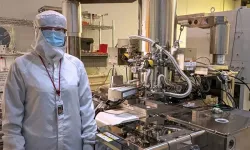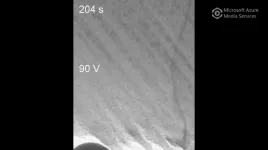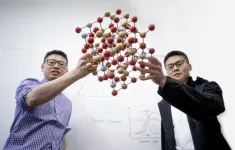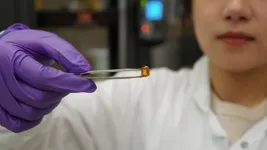(Press-News.org) A new tool for generating microwave signals could help propel advances in wireless communication, imaging, atomic clocks, and more.
Frequency combs are photonic devices that produce many equally spaced laser lines, each locked to a specific frequency to produce a comb-like structure. They can be used to generate high-frequency, stable microwave signals and scientists have been attempting to miniaturize the approach so they can be used on microchips.
Scientists have been limited in their abilities to tune these microcombs at a rate to make them effective. But a team of researchers led by University of Rochester’s Qiang Lin, professor of electrical and computer engineering and optics, outlined a new high-speed tunable microcomb in Nature Communications.
“One of the hottest areas of research in nonlinear integrated photonics is trying to produce this kind of a frequency comb on a chip-scale device,” says Lin. “We are excited to have developed the first microcomb device to produce a highly tunable microwave source.”
The device is a lithium niobate resonator that allows users to manipulate the bandwidth and frequency modulation rates several orders-of-magnitude faster than existing microcombs.
“The device provides a new approach to electro-optic processing of coherent microwaves and opens up a great avenue towards high-speed control of soliton comb lines that is crucial for many applications including frequency metrology, frequency synthesis, RADAR/LiDAR, sensing, and communication,” says Yang He ’20 (PhD), who was an electrical and computer engineering postdoctoral scholar in Lin’s lab and is the first author on the paper.
Other coauthors from Lin’s group include Raymond Lopez-Rios, Usman A. Javid, Jingwei Ling, Mingxiao Li, and Shixin Xue.
The project was a collaboration between faculty and students at Rochester’s Department of Electrical and Computer Engineering and Institute of Optics as well as the California Institute of Technology. The work was supported in part by the Defense Threat Reduction Agency, the Defense Advanced Research Projects Agency, and the National Science Foundation.
END
New microcomb device advances photonic technology
The device offers a promising new approach for photonic-based microwave signal synthesis
2023-06-21
ELSE PRESS RELEASES FROM THIS DATE:
Now, every biologist can use machine learning
2023-06-21
By Lindsay Brownell
(BOSTON) — The amount of data generated by scientists today is massive, thanks to the falling costs of sequencing technology and the increasing amount of available computing power. But parsing through all that data to uncover useful information is like searching for a molecular needle in a haystack. Machine learning (ML) and other artificial intelligence (AI) tools can dramatically speed up the process of data analysis, but most ML tools are difficult for non-ML experts to access and use. Recently, automated machine learning (AutoML) methods have been developed that can automate the design and deployment ...
University of Toronto Engineering researchers are using electric fields to control the movement of defects in crystals
2023-06-21
An international team of researchers, led by University of Toronto Engineering Professor Yu Zou, is using electric fields to control the motion of material defects. This work has important implications for improving the properties and manufacturing processes of typically brittle ionic and covalent crystals, including semiconductors — a crystalline material that is a central component of electronic chips used for computers and other modern devices.
In a new study published in Nature Materials, researchers from ...
Assessment of a peer support group intervention for undocumented Latinx immigrants with kidney failure
2023-06-21
About The Study: This study of 23 undocumented immigrants with kidney failure receiving emergency dialysis found that a peer support group intervention achieved feasibility and acceptability. The findings suggest that a peer support group may be a patient-centered strategy to build camaraderie and provide emotional support in kidney failure, especially for socially marginalized uninsured populations who report limited English proficiency.
Authors: Lilia Cervantes, M.D., of the University of Colorado, Anschutz Medical Campus, in Aurora, is the corresponding author.
To ...
Biodegradable gel shows promise for cartilage regeneration
2023-06-21
A gel that combines both stiffness and toughness is a step forward in the bid to create biodegradable implants for joint injuries, according to new UBC research.
Mimicking articular cartilage, found in our knee and hip joints, is challenging. This cartilage is key to smooth joint movement, and damage to it can cause pain, reduce function, and lead to arthritis. One potential solution is to implant artificial scaffolds made of proteins that help the cartilage regenerate itself as the scaffold biodegrades. How well the cartilage regenerates is linked to how well a scaffold can mimic the biological properties of cartilage, and to date, researchers have struggled ...
New study in Nature Water demonstrates a vastly more sustainable, cost-effective method to desalinate industrial wastewater
2023-06-21
Vanderbilt researchers are part of a team that has developed a cutting-edge method that seeks to make the removal of salt from hypersaline industrial wastewater far more energy-efficient and cost-effective.
While desalination through reverse osmosis has made tremendous strides—allowing for salt removal from seawater for less than a penny per gallon—it still falls short in eliminating saline in wastewater from industries like mining, oil and gas and power generation and in inland brackish water. The industrial brines are currently injected into deep geological formations or transferred to a evaporation ponds, and both disposal methods are facing more regulatory and ...
Researchers reveal mechanism of protection against breast and ovarian cancer
2023-06-21
In a new paper published today in Nature, researchers at the Francis Crick Institute have outlined the structure and function of a protein complex which is required to repair damaged DNA and protect against cancer.
Every time a cell replicates, mistakes can happen in the form of mutations, but specialised proteins exist to repair the damaged DNA.
People with mutations in a DNA repair protein called BRCA2 are predisposed to breast, ovarian and prostate cancers, which often develop at a young age. In the clinic, these cancers are treated with a drug that inhibits PARP, ...
Atoms realize a Laughlin state
2023-06-21
The discovery of the quantum Hall effects in the 1980's revealed the existence of novel states of matter called "Laughlin states", in honor of the American Nobel prize winner who successfully characterized them theoretically. These exotic states specifically emerge in 2D materials, at very low temperature and in the presence of an extremely strong magnetic field. In a Laughlin state, electrons form a peculiar liquid, where each electron dances around its congeners while avoiding them as much as possible. Exciting such a quantum liquid generates collective states that physicists associate to fictitious particles, whose ...
Ovarian cancer study identifies key genes for potential treatments
2023-06-21
New research is increasing our understanding about why some women with the most lethal form of ovarian cancer respond much better to treatment than others.
Researchers at Imperial College London have confirmed that the tumours of some women with high-grade serious ovarian cancer (HGSOC) contain a type of lymphoid tissue – known as tertiary lymphoid structures, or TLS – and that the presence of this tissue gives women a significantly better prognosis. They have also identified genes in HGSOC ...
Detection of an echo emitted by our Galaxy's black hole 200 years ago
2023-06-21
An international team of scientists has discovered that Sagittarius A* (Sgr A*)1, the supermassive black hole at the centre of the Milky Way, emerged from a long period of dormancy some 200 years ago. The team, led by Frédéric Marin2, a CNRS researcher at the Astronomical Strasbourg Observatory (CNRS/University of Strasbourg), has revealed the past awakening of this gigantic object, which is four million times more massive than the Sun. Their work is published in Nature on 21 June. Over a period of one year at the beginning of the 19th century, the black ...
Study hints at how cancer immunotherapy can be safer
2023-06-21
New Haven, Conn. — Cancer immunotherapy has revolutionized treatment of many forms of cancer by unleashing the immune system response against tumors. Immunotherapies that block checkpoint receptors like PD-1, proteins that limit the capacity of T cells to attack tumors, have become the choice for the treatment of numerous types of solid cancer.
However, the introduction of PD-1-blocking agents can often result in T cells attacking healthy tissues in addition to cancer cells, causing severe, sometimes life-threatening, side effects that can blunt the benefits of immunotherapy.
A new study published by researchers ...
LAST 30 PRESS RELEASES:
New prostate cancer trial seeks to reduce toxicity without sacrificing efficacy
Geometry shapes life
A CRISPR screen reveals many previously unrecognized genes required for brain development and a new neurodevelopmental disorder
Hot flush treatment has anti-breast cancer activity, study finds
Securing AI systems against growing cybersecurity threats
Longest observation of an active solar region
Why nail-biting, procrastination and other self-sabotaging behaviors are rooted in survival instincts
Regional variations in mechanical properties of porcine leptomeninges
Artificial empathy in therapy and healthcare: advancements in interpersonal interaction technologies
Why some brains switch gears more efficiently than others
UVA’s Jundong Li wins ICDM’S 2025 Tao Li Award for data mining, machine learning
UVA’s low-power, high-performance computer power player Mircea Stan earns National Academy of Inventors fellowship
Not playing by the rules: USU researcher explores filamentous algae dynamics in rivers
Do our body clocks influence our risk of dementia?
Anthropologists offer new evidence of bipedalism in long-debated fossil discovery
Safer receipt paper from wood
Dosage-sensitive genes suggest no whole-genome duplications in ancestral angiosperm
First ancient human herpesvirus genomes document their deep history with humans
Why Some Bacteria Survive Antibiotics and How to Stop Them - New study reveals that bacteria can survive antibiotic treatment through two fundamentally different “shutdown modes”
UCLA study links scar healing to dangerous placenta condition
CHANGE-seq-BE finds off-target changes in the genome from base editors
The Journal of Nuclear Medicine Ahead-of-Print Tip Sheet: January 2, 2026
Delayed or absent first dose of measles, mumps, and rubella vaccination
Trends in US preterm birth rates by household income and race and ethnicity
Study identifies potential biomarker linked to progression and brain inflammation in multiple sclerosis
Many mothers in Norway do not show up for postnatal check-ups
Researchers want to find out why quick clay is so unstable
Superradiant spins show teamwork at the quantum scale
Cleveland Clinic Research links tumor bacteria to immunotherapy resistance in head and neck cancer
First Editorial of 2026: Resisting AI slop
[Press-News.org] New microcomb device advances photonic technologyThe device offers a promising new approach for photonic-based microwave signal synthesis






